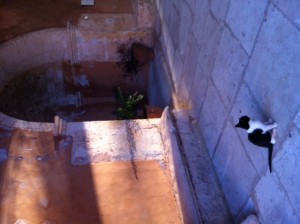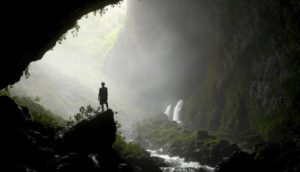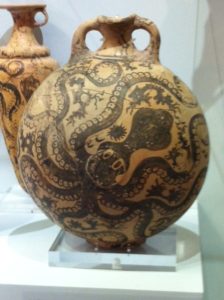CAVE OF ZEUS 
Yesterday we hiked five miles to the top of Mount Ida, the highest peak on Crete, where Zeus, in some stories, was born, and in other stories, was raised. It was also called the Philosophers Cave & it is said to have inspired Plato to write his Allegory of the Cave. We carried a couple of oak branches up the mountain because the oak is a symbol of Zeus. Our professor read from the ancient historians and told us the Seven Sages of Greece, Pythagoras, Plato, Epimenides (who, while tending his father’s sheep, fell asleep in the cave for 57 years!), and many other ancient seekers of wisdom were said to have visited the cave. 
 I saw a goat up in a tree browsing on the leaves, and the sky was dramatic with heavy black clouds, shafts of light, and fluffy cumulus. There was snow in patches close to the peak, and hail fell from the sky when we stood at the mouth of the cave. Earlier in the day after a stop along the road, we met a Greek Orthodox priest of a village church who said, “The place where you are going is sacred.” The gate was locked, so we couldn’t go into the cave, but this image is what I imagine it looks like inside.
I saw a goat up in a tree browsing on the leaves, and the sky was dramatic with heavy black clouds, shafts of light, and fluffy cumulus. There was snow in patches close to the peak, and hail fell from the sky when we stood at the mouth of the cave. Earlier in the day after a stop along the road, we met a Greek Orthodox priest of a village church who said, “The place where you are going is sacred.” The gate was locked, so we couldn’t go into the cave, but this image is what I imagine it looks like inside.
AMNISOS
At day’s end we visited the Minoan port of Amnisos. The Karteros River, which begins on Mt. Ida, meets the sea here. The volcanic eruption of Thera in 1620/8 B.C. sent a 50-foot tidal wave to Crete and destroyed the Minoan fleet, the compression force from the wave being so great it left the imprint of each ship in the sand. Finally, just before leaving the site, I got to dip my feet into the same water in which the Greek ships sailed on their way to Troy—and the same waves that tossed Odysseus up onto Nausicaa’s beach. Another magical day in this enchanted land. 
VATHYPETRO
Today, we visited a Minoan site called Vathypetro that holds the distinction of having one of the oldest vineyards, olive orchards, and winepresses in the world.  The site dates back to at least 3,500 years ago. Later, we visited a Greek Orthodox monastery where I met a new friend I wanted to bring home to California.
The site dates back to at least 3,500 years ago. Later, we visited a Greek Orthodox monastery where I met a new friend I wanted to bring home to California. 





















